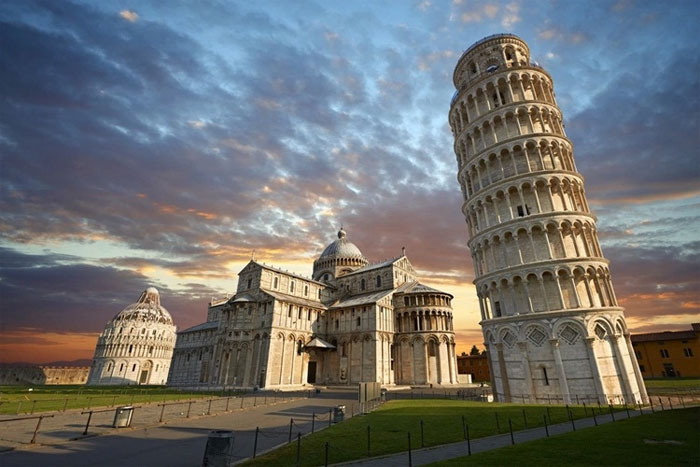The cause of Pisa tower tilt
Pisa's leaning tower, the world's most famous tilting work, is the result of the unintentional and inadequate planning of engineers.
According to Ancient Origins, Pisa tower was designed as a bell tower next to Pisa church , in Piazza del Miracoli square ( Mysterious square). This work is part of a construction project in Piazza del Miracoli, Pisa, Italy. In addition to the bell tower and the church, engineers also plan to build a baptism house and a cemetery.
The Pisa Tower is the third building built in this project, but it was finalized. Construction began in 1173. The project architect is Bonanno Pisano and Gherardo di Gherardo. By 1178, three of the eight floors of the tower were completed. But after completing the third floor, the tower began to tilt to the north.
A reason for the tower being tilted is due to the geographical characteristics of the city of Pisa itself . The name of the city appeared in 600 BC, the Greek word means "muddy land". Therefore, soft ground with the main components of mud, sand and clay, is said to be the culprit leading to the tilt of the Tower of Pisa.

Leaning Tower of Pisa is the most famous tilting building in the world.(Photo: meros).
Many other buildings in Pisa are also tilted by being built on soft ground, including the San Nicola church from the 12th century south of the leaning tower and the church of San Michele degli Scalzi in the east of the tower.
Besides, the foundation of the tower is made of a mixture of solid clay and about three meters deep. This foundation is not hard and deep enough to support the weight of the whole tower. These two factors combined led to the leaning of the Tower of Pisa.
Builders discovered that the tower was tilted, but they could do nothing to stop the process. They made the pillars and arches on the side tilted higher to continue to build on the fourth floor. However, the construction of the tower was halted for nearly a century because Pisa was constantly at war with other cities.
In 1272, the work continued to be completed under the direction of Giovanni di Simone. However, the war between Pisa and Genoa in 1284 caused the construction of the tower to stop. At that time, three floors of towers were built. This changes the center of the tower, leading to the leaning tower in the opposite direction. In 1319, the 7th floor, where the bell was placed, was constructed. This is also the highest floor of the tower and completed in 1372.
Initially, the tilt of the Pisa Tower is only 0.2 degrees. Over the centuries, this number reached 5.5 degrees in 1990. The plane difference between the top of the tower and the base of the tower is 4.6 m. Therefore, in the following years, a project was implemented to stabilize this tower.
The ground underneath the tower is leveled, the anchor devices are also installed. The tower became stronger, but continued to tilt. This is not the first time authorities have sought to prevent the tower from tilting. In 1934, the dictator Mussolini tried to do it, but attempted to counteract and increase the tilt of the tower.
In 2008, the second attempt made the tower 48cm more straight than before. This is the first time the tower has stopped moving for 800 years. Experts estimate the leaning tower of Pisa will be stable for at least 200 years.
- Pisa leaning tower is gradually straightening
- Pisa Leaning Tower - Strange architecture of the world
- Leaning Tower of Pisa
- The secret to help the leaning tower of Pisa stand before the earthquake for 800 years
- Pisa's leaning tower has been removed
- The Colosseum subsided 38cm
- Pisa leaning tower of Campo dei Miracoli
- How much is the world 'wonder' worth?
- The place has just welcomed the new year 2013, escapes
- Pisa's leaning tower will not fall for 300 years
- 90% of the world's population do not know the mysteries in these famous works
- Challenge yourself with the most difficult problem in PISA
 'Fine laughs' - Scary and painful torture in ancient times
'Fine laughs' - Scary and painful torture in ancient times The sequence of numbers 142857 of the Egyptian pyramids is known as the strangest number in the world - Why?
The sequence of numbers 142857 of the Egyptian pyramids is known as the strangest number in the world - Why? History of the iron
History of the iron What is alum?
What is alum?